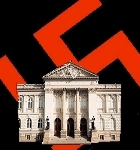It turned out to be quite an extraordinary afternoon for visitors to the Zachęta gallery in Warsaw on 17 November. Just after 4pm, famous Polish film actor Daniel Olbrychski entered the gallery, and, being a household name, he was not asked by the porter to leave his coat in the cloakroom. He proceeded directly to the exhibition room, where Piotr Uklański's much-talked-about exhibition "The Nazis" was on display.
Following the actor were a TV news crew and photographers, who filmed Olbrychski as he took out a saber and slashed pictures hanging in the exhibition room. After only a few seconds, pictures of four Nazi officers—among them Jean-Paul Belmondo—had fallen victim to this bizarre attack.
Nothing new here
"The Nazis" is not an exhibition of recently discovered pictures of Hitler's executioners displayed as a reminder of past atrocities. Certainly, the exhibition is a reminder of those times, but it is much different from the pictures of this era that are normally encountered.
The collection of pictures shows a number of famous actors in Nazi uniforms, including Clint Eastwood, Anthony Quinn—and Daniel Olbrychski. Despite the unbearable associations the costumes carry, the actors all look fantastic in the uniforms. "That's a great picture," and similiar statements are frequently overheard in the exhibition room.
But what are people praising? The pictures, as they are, or the Nazis themselves? Perhaps it was Uklański's intention to evoke acceptance and acclaim, only then to make people realize that they acclaim depictions of people who slew their grandparents. Pardon me—depictions of people made to look like people who slew their grandparents.
It seems Daniel Olbrychski did not understand the idea of the exhibition at all. "No one asked me whether I agreed to have my face displayed on an exhibition entitled 'The Nazis,'" Olbrychski complained after his fencing exploits. "My moral injury is worth much more," he added, after he was told that Zachęta director Anda Rottenberg estimated that the value of the destroyed pieces exceeds USD 60,000.
It's all in the name
It seems that Uklański's choice to name his exhibition "The Nazis" is the source of all the controversy. The exhibition—which also visited galleries in London and New York—only makes the beholder realize that the image of the Nazis has long been incorporated into mass culture, and not without a certain positive aura.
Books on Hitler, the Third Reich, its military campaigns and their generals are very popular in Poland, and elsewhere for that matter. Go to any Polish bookshop and you will see many huge volumes with swastikas on their glossy covers.
Certainly a swastika, through its established associations, draws more attention than the Polish eagle, and it is hard to discern the main component of this attention. Is it the historical knowledge that makes us look down on it or an appeal aroused by its aggressive design?
The same applies for men in the Nazi uniforms. Uklański asks all the questions in an exhibition that really stands for what modern artists have been trying to tell us. This is a far cry from such cheap and simplistic endeavors as submerging a crucifix in urine or building a concentration camp out of Lego blocks.
First of all, it does not contrast anything. It simply shows pictures of

|
Although Olbrychski said, "I cannot express my contempt for Zachęta's director, for her decision to allow this exhibition, which praises the uniform of murderers and enemies of human kind, to be shown," it seems he failed to notice that he contributed to this appraisal himself. After all, he could have rejected the role in which he portrayed a Nazi—for Claude Lelouch's Les uns et les autres (Within Memory aka Bolero, 1981).
Reacting to Olbrychski's hysterical act, Teresa Wasilewska of the Warsaw Center of Contemporary Art said: "Contemporary art works are difficult in reception. [...] artists search for problems, touch upon taboos. But people are tired of it. They'd rather rest at exhibitions instead of think."
Cheap, attention-drawing trick as it was, Olbrychski's action at Zachęta resulted in Minister of Culture Kazimierz Ujazdowski's ruining the thought-provoking concept Uklański had in mind. The Minister ordered that either the exhibition be accompanied by a commentary saying the exhibition's message is to condemn fascism or it should be closed down. Uklański, however, did not agree to the addition of the commentary and called the Minister's decision an act of censorship.
The exhibition was subsequently closed. Thank you, Minister.
Wojtek Kość, 4 December 2000
Moving on:
- Archive of articles on Polish culture in CER
- Browse through the CER eBookstore for electronic books
- Buy English-language books on Central and Eastern Europe through CER
- Return to CER front page




